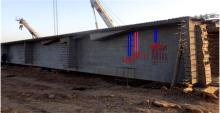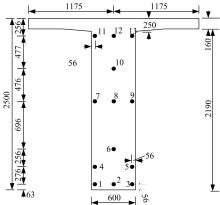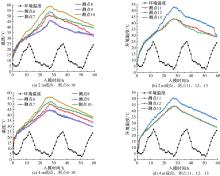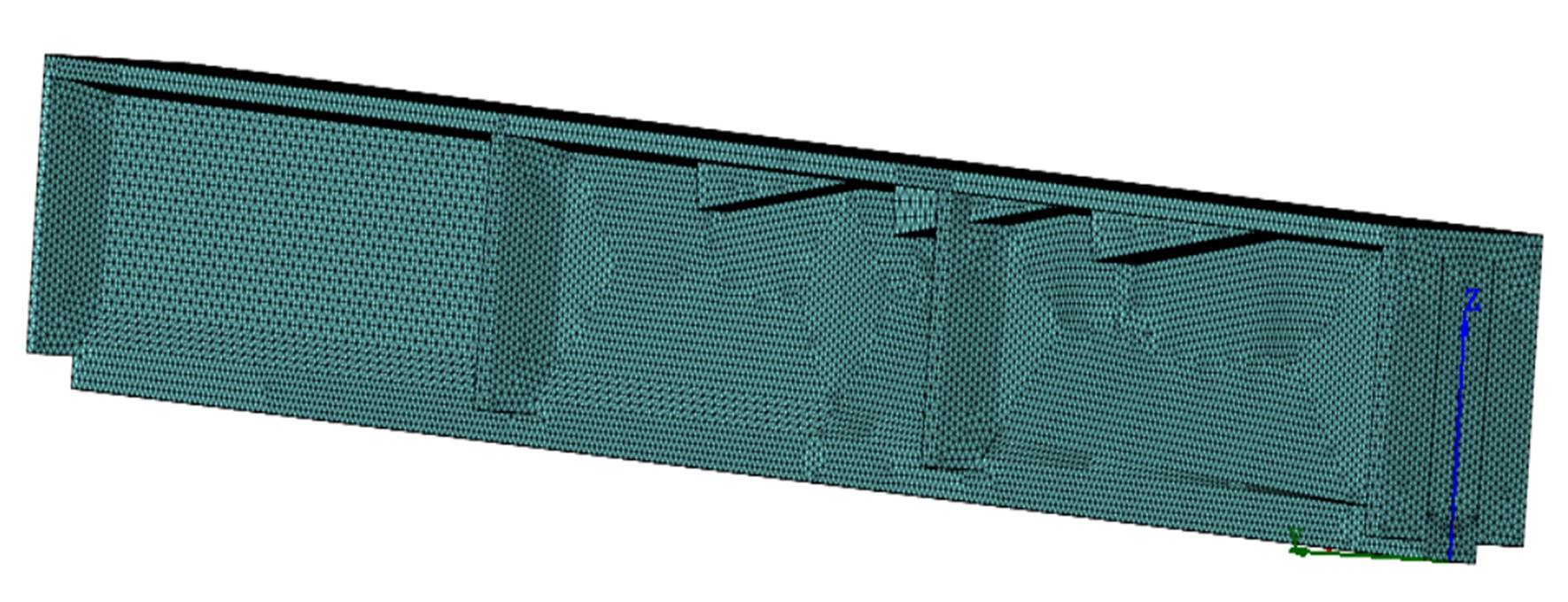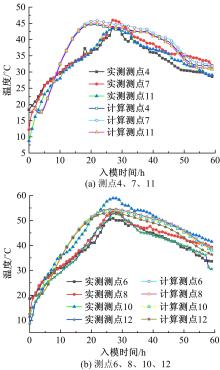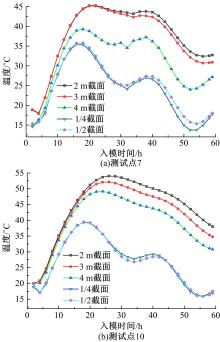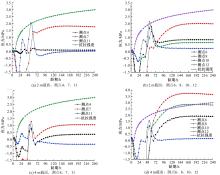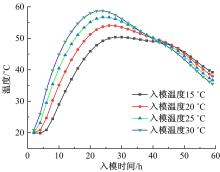Journal of Jilin University(Engineering and Technology Edition) ›› 2021, Vol. 51 ›› Issue (5): 1734-1741.doi: 10.13229/j.cnki.jdxbgxb20200599
Effect of hydration heat temperature and cracking mechanism of beam end in early stage of T⁃beam
Ying-xin HUI1,2,3( ),Xiao-rong SUN1,Hong-yu WANG1,Chen GAO1
),Xiao-rong SUN1,Hong-yu WANG1,Chen GAO1
- 1.School of Civil and Hydraulic Engineering,Ningxia University,Yinchuan 750021,China
2.Ningxia Communications Construction Co. ,Ltd. ,Yinchuan 750002,China
3.Ningxia Engineering Technology Research Center for Road Maintenance,Yinchuan 750002,China
CLC Number:
- U441
| 1 | 宿晓萍, 王清. 复合盐浸-冻融-干湿多因素作用下的混凝土腐蚀破坏[J]. 吉林大学学报: 工学版, 2015, 45(1): 112-120. |
| Su Xiao-ping, Wang Qing. Corrosion damage of concrete under multi-salt soaking, freezing-thawing and dry-wet cycles[J]. Journal of Jilin University(Engineering and Technology Edition), 2015, 45(1): 112-120. | |
| 2 | 张宁, 周鑫, 刘永健, 等. 基于点阵式测量的混凝土箱梁水化热温度场原位试验[J]. 土木工程学报, 2019, 52(3) :76-86. |
| Zhang Ning, Zhou Xin, Liu Yong-jian, et al. In-situ test on hydration heat temperature of box girder based on array measurement[J]. China Civil Engineering Journal, 2019, 52(3): 76-86. | |
| 3 | 戴公连, 岳喆. 混凝土箱梁早期温度测试与分析[J].武汉大学学报: 工学版, 2019, 52(2): 139-144. |
| Dai Gong-lian, Yue Zhe. Test and analysis of early temperature of concrete box girder[J]. Engineering Journal of Wuhan University, 2019, 52(2): 139-144. | |
| 4 | 顾斌, 陈志坚, 陈欣迪. 大跨径混凝土箱梁桥有效温度与应变的实测分析[J]. 吉林大学学报: 工学版, 2013, 43(4): 877-884. |
| Gu Bin, Chen Zhi-jian, Chen Xin-di. Analysis of measured effective temperature and strains of long-span concrete box girder bridge[J]. Journal of Jilin University(Engineering and Technology Edition), 2013, 43(4): 877-884. | |
| 5 | Taysi N, Abid S R. Temperature distributions and variations in concrete box-girder bridges: experimental and finite element parametric studies[J]. Advances in Structural Engineering, 2015, 4(18): 469-486. |
| 6 | Wang Y B, Zhan Y L, Zhao R D. Analysis of thermal behavior on concrete box-girder arch bridges under convection and solar radiation[J]. Advances in Structural Engineering, 2016, 19(7): 1043-1059. |
| 7 | 李昀. 预应力混凝土T梁裂缝成因分析与处理[J].铁道科学与工程学报, 2015, 12(2): 330-334. |
| Li Yun. Cause analysis and treatment of cracks in prestressed concrete T beams[J]. Journal of Railway Science and Engineering, 2015, 12(2): 330-334. | |
| 8 | 朱伯芳. 大体积混凝土温度应力与温度控制[M]. 北京: 中国电力出版社, 2012. |
| 9 | Zhu S Y, Cai C B. Interface damage and its effect on vibrations of slab track under temperature and vehicle dynamic loads[J]. International Journal of Non-Linear Mechanics, 2014, 58(1): 222-232. |
| 10 | 彭友松. 混凝土桥梁结构日照温度效应理论及应用研究[D]. 成都: 西南交通大学土木工程学院, 2007. |
| Peng You-song. Studies on theory of solar radiation thermal effects on concrete bridges with application [D]. Chengdu: College of Civil Engineering, Southwest Jiaotong University, 2007. | |
| 11 | Zhu J S, Meng Q L. Effective and fine analysis for temperature effect of bridges in natural environments[J]. Journal of Bridge Engineering, 2017, 22(6): 1-19. |
| 12 | 汪建群, 方志, 刘杰. 大跨预应力混凝土箱梁水化热测试与分析[J]. 桥梁建设, 2016, 46(5): 29-34. |
| Wang Jian-qun, Fang Zhi, Liu Jie. Measurement and analysis of hydration heat of long span PC Box- girders[J]. Bridge Construction, 2016, 46(5): 29-34. | |
| 13 | 朱伯芳. 水工混凝土结构的温度应力与温度控制[M]. 北京: 水科电力出版社, 1976. |
| 14 | 宋军, 石雪飞, 阮欣. 大体积混凝土热学参数识别的优化[J]. 吉林大学学报: 工学版, 2018, 48(5): 1418-1425. |
| Song Jun, Shi Xue-fei, Ruan Xin. Optimization of thermal parameter identification for mass concrete[J]. Journal of Jilin University(Engineering and Technology Edition), 2018, 48(5): 1418-1425. |
| [1] | Jin-guo WANG,Kai HUANG,Rui-fang YAN,Shuai REN,Zhi-qiang WANG,Jin GUO. Effect of carbon equivalent elements on fluidity of hypoeutectic ductile iron by cellular automata finite element method [J]. Journal of Jilin University(Engineering and Technology Edition), 2021, 51(3): 855-865. |
| [2] | Chun-guo LIU,Xiao-tong YU,Tao YUE,Dong-lai LI,Ming-zhe ZHANG. Springback prediction for double-curvature stiffened panel during milling [J]. Journal of Jilin University(Engineering and Technology Edition), 2021, 51(1): 188-199. |
| [3] | Er-gang XIONG,Han XU,Ci TAN,Jing WANG,Ruo-yu DING. Shear strength of reinforced concrete beams based on elastoplastic stress field theory [J]. Journal of Jilin University(Engineering and Technology Edition), 2021, 51(1): 259-267. |
| [4] | Fan YANG,Xu-dong ZHANG,Meng ZHAO,Bo SHE,Jun-kai DENG. Deformation behavior of shape memory alloy-metallic glass matrix composites based on finite element calculations [J]. Journal of Jilin University(Engineering and Technology Edition), 2021, 51(1): 172-180. |
| [5] | Xin LI,Yan-peng SUN,Dan WANG,Jun-xu CHEN,Zheng-wei GU,Hong XU. Finite element numerical simulation for automobile front floor forming [J]. Journal of Jilin University(Engineering and Technology Edition), 2019, 49(5): 1608-1614. |
| [6] | Yan-qin ZHANG,Ya-nan FENG,Peng-rui KONG,Xiao-dong YU,Xiang-bin KONG. Temperature field and experiment of hydrostatic bearing oil film based on hot oil carrying [J]. Journal of Jilin University(Engineering and Technology Edition), 2019, 49(4): 1203-1211. |
| [7] | Yu⁃peng LI,Da⁃qian SUN,Wen⁃biao GONG. Temperature fields in bobbin⁃tool friction stir welding for 6082⁃T6 aluminum alloy sheet [J]. Journal of Jilin University(Engineering and Technology Edition), 2019, 49(3): 836-841. |
| [8] | Xiao⁃qin ZHOU,Lu YANG,Lei ZHANG,Li⁃jun CHEN. Finite element analysis of hinging octahedron structure withnegative compressibility [J]. Journal of Jilin University(Engineering and Technology Edition), 2019, 49(3): 865-871. |
| [9] | BI Qiu-shi,WANG Guo-qiang,HUANG Ting-ting,MAO Rui,LU Yan-peng. Tooth strength analysis of mineral sizer by coupling discrete element method and finite element method [J]. Journal of Jilin University(Engineering and Technology Edition), 2018, 48(6): 1770-1776. |
| [10] | LIU Zhi-feng, ZHAO Dai-hong, WANG Yu-mo, HUN Lian-ming, ZHAO Yong-sheng, DONG Xiang-min. Relationship between bearing capacity of heavy machine hydrostatic rotary table and temperature field distribution of oil pad [J]. 吉林大学学报(工学版), 2018, 48(3): 773-780. |
| [11] | SUN Rong-jun, GU Shuan-cheng, JU Pei, GAO Ke. Optimal design of new arc angle PDC drill bit for coal mining based on finite element method [J]. 吉林大学学报(工学版), 2017, 47(6): 1991-1998. |
| [12] | WANG Jing-yu, YU Xu-tao, HU Xing-jun, GUO Peng, XIN Li, GUO Feng, ZHANG Yang-hui. Fluid-induced vibration and flow mechanism of automotive external rearview mirror [J]. 吉林大学学报(工学版), 2017, 47(6): 1669-1676. |
| [13] | LIU Yu, LI Peng-fei, ZHANG Yi-min. Analysis and prediction of micro milling deformation of copper thin-wall parts [J]. 吉林大学学报(工学版), 2017, 47(3): 844-849. |
| [14] | ZHANG Yun-long, LIU Zhan-ying, WU Chun-li, WANG Jing. Static and dynamic responses of steel-concrete composite beams [J]. 吉林大学学报(工学版), 2017, 47(3): 789-795. |
| [15] | WANG Guo-lin, SUN Yan-tian, LIANG Chen, YANG Jian, ZHOU Hai-chao. Contour design of radial tire based on full stress theory [J]. 吉林大学学报(工学版), 2017, 47(2): 365-372. |
|
||
